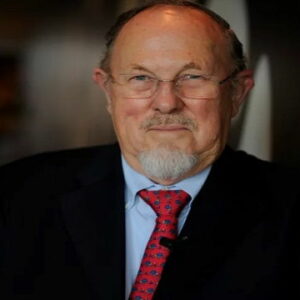William Forsyth Sharpe is an American economist who created the “Capital Asset Pricing Model.” This model won him the Nobel Memorial Prize for Economic Sciences. He made the Sharpe Ratio, which is a way to measure how well an investment is doing. He also came up with the “binomial method” for judging options, the “optimization of asset allocation” method, and the “returns method” for judging how well investments are doing based on how much money they bring in. He started with Harry Markowitz’s “portfolio theory” and then made the “Capital Asset Pricing Model,” or CAPM. This model could be used by any type of investor, no matter if their portfolio had a lot of risky assets or was mostly made up of safe assets like insured bank deposits. He said that the value “beta” should be used to measure the risk in a portfolio that can’t be reduced. This meant that if the portfolio’s “beta” value was 1.5, the portfolio’s value could go up by 15% if the stock market went up by 10%. On the other hand, a drop of 10% in the stock market could cause the value to go down by 15%. This became the standard way to figure out how much all the shares in a portfolio have made in total.
Early years and childhood
William Sharpe was born on June 16, 1934, in Boston, Massachusetts, USA.
William went to “Riverside Polytechnic High School” for high school and graduated in 1951.
In 1951, he went to “The University of California, Berkeley” to study medicine.
Before the first year was over, he changed his mind and went to the “University of California at Los Angeles” to study business instead.
Accountancy and economics are the two main subjects, but he chose to major in economics because he thought accountancy was too simple.
In 1955, he got his B.A. in economics from UCLA. In 1956, he got his M.A. from UCLA.
After a short time in the Army, he went to work for the RAND Corporation in 1956 to do research. He also began working on his Ph.D. thesis with the help of Harry Markowitz.
In 1961, he worked at Rand Corporation and got his Ph.D. from UCLA.
William Sharpe’s Career
In 1961, William Sharpe moved to Seattle and became a professor of finance at the University of Washington’s School of Business.
He started doing research on how to price assets while he was teaching at this university. He came up with the “Capital Asset Pricing Model,” or CAPM.
He worked at the University of Washington until 1968 when he took a year off to work for the Rand Corporation.
In 1968, he went to the “University of California at Irvine.” He only went to this college for a couple of years.
In 1970, he moved to ‘Stanford University’ and joined the ‘Graduate School of Business,’ where he taught and did research in addition to teaching.
In 1973, Stanford made him the “Timken Professor of Finance.”
In 1974, he started a study about the role of investment policy in pension funds. During this time, he also started working as a consultant for “Merrill Lynch,” “Pierce, Fenner, and Smith,” and “Wells Fargo,” where he could put his ideas about money to use.
During the school year 1976–1977, he worked at the National Bureau of Economic Research (NBER) to study the effects of bank capital.
In 1980, the “American Finance Association” chose him to be its president.
He worked for the College Retirement Equities Fund and the Research Foundation of the Institute of Chartered Financial Analysts from 1975 to 1983. He was on the Council on Education and Research of the Institute of Chartered Financial Analysts and the Institute of Quantitative Research in Finance.
He was also a “Strategic Advisor” for Nikko Securities’ Institute of Investment Technology and worked in the Union Bank of Switzerland’s “Portfolio Management” department.
In 1986, he worked with Frank Russell to start the Sharpe-Russell Research company. This company helped foundations and pension funds decide how to divide up their assets.
He stopped teaching in 1989, but he still worked at Stanford University as a “Timken Professor Emeritus of Finance.”
After he retired, he put a lot of time into his consulting business, which was called “William Sharpe Associates.”
He started the company Financial Engines, or FNGN, which started using new technologies to put his ideas about portfolio management into practice in the real world.
He became president of the “American Finance Association” and a trustee for “Economists for Peace and Security.”
He has been promoting “adaptive asset allocation strategies” as a way to use the latest market trends to optimize asset allocation for maximum returns and low volatility.
Works of note
In 1963 and 1964, William Sharpe wrote papers called “A Simplified Model for Portfolio Analysis” and “Capital Asset Prices: A Theory of Market Equilibrium Under Conditions of Risk.”
His first book, “Portfolio Theory and Capital Markets,” came out in 1970 and again in 2000. His second, “Asset Allocation Tools,” came out in 1987.
In 1999 and 2000, he wrote two more books with Jeffrey Bailey and Gordon J. Alexander. They were called “Investments” and “Fundamentals of Investments.” The book “Selected Works of William F. Sharpe” came out in 2012.
Awards & Achievements
William Sharpe got a “Doctor of Humane Letters, Honoris Causa” from DePaul University and a “Doctor Honoris Causa” from both the University of Alicante in Spain and the University of Vienna in Austria.
He also got the “UCLA Medal,” which is UCLA’s highest award.
In 1990, he was given the Nobel Prize in Economics.
Personal History and Legacies
In 1986, well-known painter Kathryn married William Sharpe.
The marriage gave them a daughter named Deborah and a son named Jonathan.
Estimated Net worth
Unknown.
Trivia
William Sharpe likes to go sailing, play football, shoot hoops, and go to the opera.


